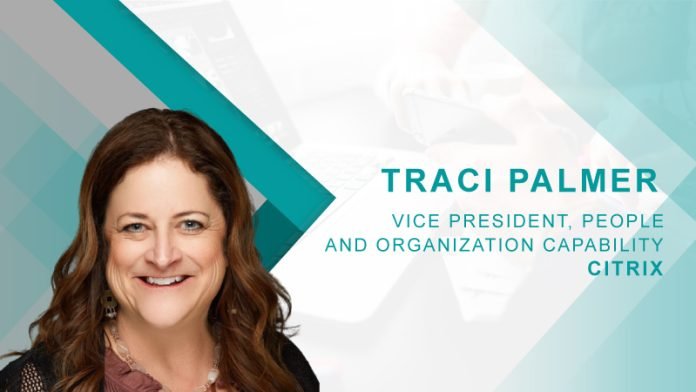Traci Palmer discusses the need to create work-from anywhere experiences to power the future of work.
1. Tell us about your role at Citrix.
My role itself is multifaceted and sometimes a little difficult to explain, but at the end of the day, it’s about driving organizational effectiveness and results through ensuring our talent can perform at their best. That can be anything from designing talent management and talent development programs that build skills and capability, to fostering a strong culture through our talent programs and continuous listening strategy, to driving the organizational readiness and adoption of transformative business changes, to leading the design and evolution of our hybrid and remote working model, which we call The Space to Succeed.
2. Work today is different. How are things changing?
The way we think about work – and the expectations we have – are completely different than they were three years ago. Going to work used to mean heading to the office. But work is no longer a place. It’s wherever employees get their best work done, and that can be at home, in the office, on the road and anywhere in between.
Employees today want the flexibility to work when, where and how they choose.
And in today’s tight talent market, companies need to offer flexibility to attract and retain the talent they need to innovate and grow. We just did a global survey, and 57 percent of the respondents said they prefer hybrid models that allow them to work remote or in the office. And 69 percent said they will leave their jobs if it they aren’t given the option.
3. What does the future of work look like?
Hybrid work is the future of work and I think you will see more organizations adopt flexible models that empower employees to choose where and how they work best – based on what they need to accomplish on a given day. Employees really are divided on how they want to work. If you look at the same survey I just referenced, 71 percent of employees currently work or plan to work in the office between one and four days per week; 56 percent are or plan to be in the office full time; 49 percent work from shared and communal workspaces between one and four days per week; and 49 percent are fully remote and plan to be permanently.
So not everyone will be working remotely, or for that matter, in the office.
4. Are there challenges to hybrid work?
The fully remote work model forced by the pandemic has in many ways leveled the playing field. Everyone appears in equal boxes on the screen and has the same access to information and opportunities to contribute to a project, develop and grow. As companies move toward hybrid models, they need to maintain this consistent, inclusive experience to ensure that employees are not at a disadvantage because of where they choose to work.
And that’s going to require some out-of-the-box thinking to pull off. Many managers still view work in terms of time spent in the office and are skeptical that real work can get done anywhere else.
And that has to change. According to our research, 72 percent of employees say they work the same or more hours when working from home. And nearly 70 percent of workers believe they are as, if not more productive.
Additionally, we have seen that working remotely can result in longer hours and lack of separation between home and work, creating fatigue and burnout. And both are increasing stress levels that are already at an all-time high.
The bottom line is, employees today need to be trusted to work from wherever they are most effective and evaluated on performance outcomes instead of output. And teams need to focus on establishing norms around things such as how they collaborate, make decisions, create an inclusive environment, and set work/life boundaries.
Companies also need to rethink what “workplace” really means. Employees aren’t looking to return to the past where they worked in the office five days a week. They want to be empowered to work when, where and how they work best. Instead of physical office spaces, companies need to focus on creating work-from-anywhere experiences so that wherever they are working from employees have the tools and resources they need to get things done.
5. How can technology be used to do this?
As the saying goes, “never let a good crisis go to waste.” Leveraging many of the same technologies that got them through the pandemic, companies can create a common and transparent environment that gives employees the space and tools they need to succeed. Take Citrix digital workspace solutions. Whether they are at home, on plane or in the office, employees can securely access all the resources they need to get work done, wherever it needs to get done, and on any device. And whether they are sitting in a conference room next to a co-worker or working with teams across multiple geographies online, they have equal ability to contribute and execute work, and be recognized and rewarded for their accomplishments.
With the right digital workspace platform, companies can also enhance the employee experience, which has never mattered more. In the rush to enable remote work, companies delivered tools employees could use to collaborate with their colleagues, customers and partners regardless of where they happened to be. But many companies pushed out too many that employees say are too hard to use and have made work more complex. We did some research that shows 64 percent of employees are using more communication and collaboration tools than they were prior to the pandemic. They’re frustrated, and it’s slowing them down.
With Citrix, companies can eliminate the friction and noise from work by creating a unified digital workspace where employees can easily tap into the apps they need and prefer to use in a simple, secure way.
6. You mention security. How do you balance giving employees the flexibility they demand against the need to protect corporate information and devices?
It all comes down to having the right technology. Digital workspaces are like a secure bubble where everything happens and are the ticket to balancing the need to give employees the flexibility and choice they demand while keeping corporate information and devices safe. Whether people are working in the office or remotely, they’re always connected to a virtual desktop which runs from a datacenter – either on-prem or in the cloud. When they are accessing documents or receiving emails, there’s no data going to their devices. It all happens within the workspace. So, if someone is in a coffee shop and their laptop gets stolen, there is nothing on it.
7. What advice would you offer to organizations that are on the fence when it comes to flexible work?
Realize that when people are given the ability to match their work environment to the outcomes they need to deliver, they will perform at their best. And where in the past offering flexibility or hybrid working arrangements was a perk, it’s now considered table stakes and will continue to be critical to attracting and retaining talent. If companies don’t adapt, they will fall behind.
For more such Updates Log on to www.hrtechcube.com

Traci Palmer Vice President, People and Organization Capability, Citrix
Traci Palmer is VP of People & Organization Capability at Citrix. In her role, Traci is responsible for designing and delivering global talent management, organization development, and talent development.













